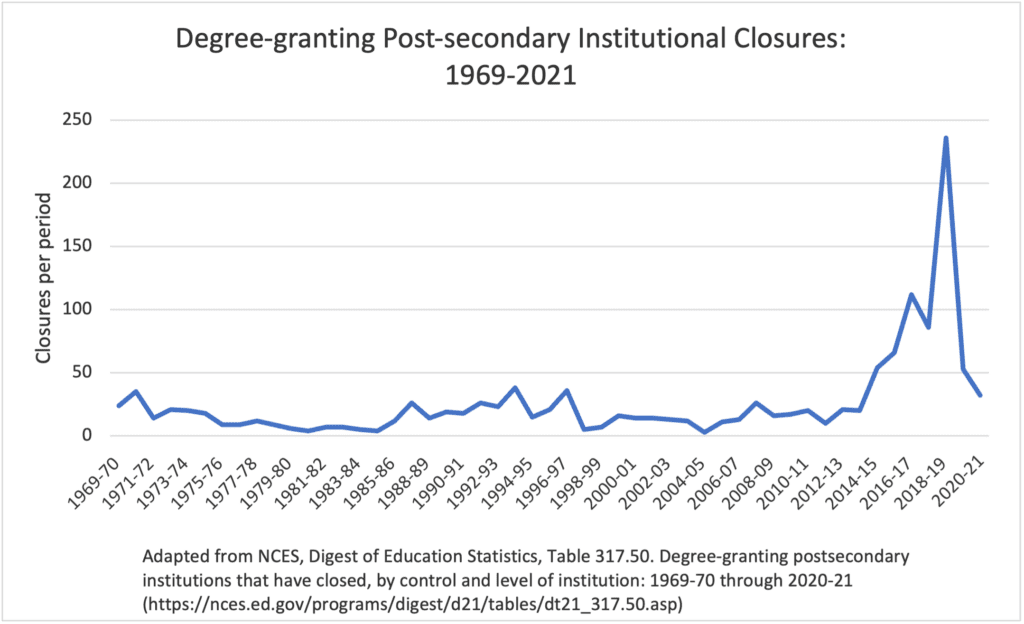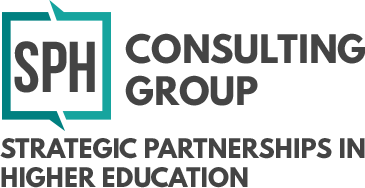College Closures: Reading the Wave
June 26, 2023

Recently, Lee Gardner wrote a nice piece entitled ‘When It Comes to College Closures, the Sky Is Never Going to Fall’, where he noted that he has become tired of the decade-long prediction that we would see a wave of college closures. He notes that “the shakeout didn’t come. And at this point, I don’t expect it this year, or next year. Or ever, maybe”. I do feel bad for him, as there are few things worse than unrequited expectations.
But I do think he is looking at the data with a somewhat biased perspective. For starters, what is a wave anyway? And what is its shape? Let us look at the data to understand that question.
NCES data has noted that between 1969 and 2009 there were 619 closures; in the eleven years between 2010 and 2021 there have been 710 closures. Overall, about 15% of all degree-granting institutions in the U.S. have closed in the past decade or so. A number greater than that of all school closures in the prior 40 years. While this may not be the tsunami that Lee expected it is a ‘wave’ (see graph).

And a wave that has been felt by a growing number of students. The recent analysis by the National Student Clearinghouse Research Center (NSCRC), in collaboration with the State Higher Education Executive Officers Association (SHEEO), reported on 467 institutions that closed between July 1, 2004, and June 30, 2020. Closures that impacted 143,215 students. An enormous number of individuals affected. Students that were more often of color or disadvantaged. And worse, two-thirds of the students whose colleges closed experienced an abrupt and unplanned closure which detrimentally affected the students’ chances of reenrollment. In fact, almost 90% of the students in the study who did not earn a credential and did not reenroll had experienced an abrupt institutional closure.
It is possible that some of the school closures reported by NCES may have been recorded as ‘closed’ if they had merged with another institution. Unfortunately, our own research indicates that the number of closures far outweighs that of mergers, in a ratio that approximates 7:1. While not all schools can, or should be saved, many of them could have found that a merger with another institution was a good strategic solution – for the preservation of their heritage and their mission, and most importantly, for the benefit of their students.
Unfortunately, most schools, as Lee indicates, “may look for partnerships, mergers, and buyers, although sometimes when it’s far too late.” Waiting too long to search for an institutional partner often results in schools without much left in the way of financial, enrollment, or brand equity. While other institutions, including sister schools, may be willing to assist the failing colleges’ students, through teach-outs, transfer agreements, and the like, few will be willing to, or should, risk their own financial health in the venture.
One of the important points that Lee makes is that institutional leaders, boards and chief executives, will do whatever it takes to keep their institution independent… And the result can be what we have termed ‘Zombie Colleges’. Schools that have progressively declining enrollment and finances, with limited operating cash reserves, often with only enough finances to get them to the end of the academic year – if they are careful – but without the resources needed to mount an effective counter-offensive. In a preliminary analysis, we identified at least 200 Title IV institutions that currently fit the definition. And which will remain so until a catastrophic event, such as a ransomware attack or significant drop in enrollment, spells their end.
So, while we may not (yet) have seen the tsunami that Lee was expecting, there clearly is a wave of closures. And more will continue, as higher education faces excess capacity and a collective loss of 2.0 million students since 2011. A number equivalent to the entire enrollment of almost one-half the schools with less than 5000 students.
So what to do? Colleges and universities should begin to systematically perform 5-year financial planning (yes, you can model most future elements, even the unexpected), begin to consider strategic partnerships, including mergers and acquisitions early, … and never let hope be the guiding plan.
To learn more about SPH Consulting Group and how we can help your organization, contact office@sphconsultinggroup.com.
Writer: Ricardo Azziz, Principal, SPH Consulting Group.
[1] Of closures since 1969, 4.1% were public and 95.9% were private. Of closures of private institutions since 1990 (when private colleges were classified into non-profits and for-profits), 75.1% of closures have been in the for-profit sector.
